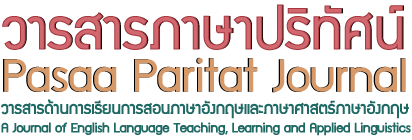การวิเคราะห์ภูมิศาสตร์ทางภาษาศาสตร์ของอุทยานประวัติศาสตร์สุโขทัย
DOI:
https://doi.org/10.58837/CHULA.PPJ.39.6คำสำคัญ:
ภูมิศาสตร์ทางภาษาศาสตร์, ป้ายสาธารณะ, การใช้ภาษา, อุทยานประวัติศาสตร์สุโขทัย, ภาษาอังกฤษในฐานะภาษานานาชาติบทคัดย่อ
งานวิจัยนี้มีวัตถุประสงค์เพื่อศึกษาภูมิศาสตร์ทางภาษาศาสตร์ของอุทยานประวัติศาสตร์สุโขทัยโดยพิจารณาประเภทของป้ายสาธารณะและการเลือกใช้ภาษาในป้าย รวมถึงการสำรวจความคิดเห็นของเจ้าหน้าที่ของรัฐ มัคคุเทศก์ และนักท่องเที่ยว ต่อบทบาทของภาษาอังกฤษที่ปรากฏอยู่ในพื้นที่ที่ศึกษา ป้ายจำนวน 288 ภาพ ได้นำมาจัดหมวดหมู่ เพื่อจำแนกออกเป็นหลากหลายประเภทของภูมิทัศน์ทางภาษาศาสตร์ ผลการวิเคราะห์ ได้แบ่งกลุ่มของป้ายออกเป็นหลากหลายประเภท ได้แก่ ป้ายชื่อ (29.51%) ป้ายจราจร (23.96%) ป้ายข้อมูล (15.97%) ป้ายคุณธรรมและจริยธรรม (15.28%) ป้ายกฎข้อบังคับ (10.07%) และ ป้ายแผนที่ (5.21%) การเลือกใช้ภาษาที่ปรากฏในป้ายได้ผ่านการวิเคราะห์อย่างละเอียด และแสดงให้เห็นว่า ตัวอักษรที่ใช้ในป้ายส่วนใหญ่ในพื้นที่วิจัยแบ่งเป็น “ป้ายที่ใช้ตัวอักษรภาษาไทยล้วน” (9.37%) “ป้ายที่ใช้ตัวอักษรภาษาอังกฤษล้วน” (5.56%) และ “ป้ายสองภาษาโดยใช้ภาษาไทยและภาษาอังกฤษควบคู่กันโดยมีความหมายเดียวกันในทั้งสองภาษา” (85.07%) ภาษาอังกฤษที่ปรากฏในป้ายบ่งชี้ถึงกลยุทธ์ในการดึงดูดนักท่องเที่ยวจากนานาชาติ เนื่องจากภาษาอังกฤษช่วยให้เข้าใจข้อความที่ต้องการสืื่อได้ง่าย นอกจากนั้น ผู้วิจัยเก็บข้อมูลผ่านการการสัมภาษณ์แบบกึ่งโครงสร้าง กับ พนักงานรัฐบาลท้องถิ่น, มัคคุเทศก์, และนักท่องเที่ยวชาวต่างชาติ จำนวน 15 คน ผลการวิจัยแสดงให้ว่า ภาษาอังกฤษมีประโยชน์ต่อการให้ข้อแนะนำ ตอบสนองต่อความต้องการด้านการท่องเที่ยว และโฆษณาเผยแพร่ ภาษาอังกฤษนำมาใช้เพื่อช่วยในการสื่อสาร อำนวยความสะดวกให้กับนักท่องเที่ยวต่างชาติ และ สื่อถึงความเป็นนานาชาติและทันสมัย
เอกสารอ้างอิง
Akindele, D. O. (2011). Linguistic landscapes as public communication: A study of public signage in Gaborone Botswana. International Journal of Linguistics, 3(1), 1–11. https://doi.org/10.5296/ijl.v3i1.1157
Backhaus, P. (2006). Multilingualism in Tokyo: A look into the linguistic landscape. International Journal of Multilingualism, 3(1), 52–66. https://doi.org/10.1080/14790710608668385
Ben-Rafael, E., Shohamy, E., Amara, M. H., & Trumper-Hecht, N. (2006). Linguistic landscape as symbolic construction of the public space: The case of Israel. International Journal of Multilingualism, 3(1), 7–30. https://doi.org/10.1080/14790710608668383
Blommaert, J. (2013). Ethnography, superdiversity and linguistic landscapes: Chronicles of complexity. Multilingual Matters. https://doi.org/10.21832/9781783090419
Gorter, D. (2006). Linguistic landscape: A new approach to multilingualism. Multilingual Matters.
Gorter, D. (2018). Methods and techniques for linguistic landscape research: About definitions, core issues and technological innovations. In M. Pütz & N.-F. Mundt (Eds.), Expanding the linguistic landscape: Linguistic diversity, multimodality and the use of space as a semiotic resource (pp. 38–57). Multilingual Matters. https://doi.org/10.21832/9781788922166
Gorter, D., & Cenoz, J. (2007). Knowledge about Language and Linguistic Landscape. In N. H. Hornberger (Ed.), Encyclopedia of Language and Education (2nd rev. ed.) (pp. 1–13). Springer Sciences. https://doi.org/10.1007/978-0-387-30424-3_160
Guilat, Y., & Espinosa-Ramírez, A. B. (2016). The Historical Memory Law and its role in redesigning semiotic cityscapes in Spain: A case study from Granada. Linguistic Landscape: An International Journal, 2(3), 247–274. https://doi.org/10.1075/ll.2.3
Hicks, D. (2002, April). Scotlands linguistic landscape: the lack of policy and planning with Scotland´s place-names and signage. World Congress on Language Policies, Barcelona.
Hornsby, M. (2008). The incongruence of the Breton linguistic landscape for young speakers of Breton. Journal of Multilingual and Multicultural Development 29(2), 127–138. https://doi.org/10.2167/jmmd538.0
Huebner, T. (2006). Bangkok’s linguistic landscapes: Environmental print, codemixing, and language change. In D. Gorter (Ed.), Linguistic landscape: A new approach to multilingualism. Multilingual Matters. https://doi.org/10.1080/14790710608668384
Hult, F. M. (2013). Drive-thru linguistic landscaping: Constructing a linguistically dominant place in a bilingual space. International Journal of Bilingualism, 18(5), 507–523. https://doi.org/10.1177/1367006913484206
Kasanga, L. A. (2012). English in the Democratic Republic of the Congo. World Englishes, 31(1), 48–69. https://doi.org/10.1111/j.1467-971X.2011.01732.x
Landry, R., & Bourhis, R. Y. (1997). Linguistic landscape and ethnolinguistic vitality: An empirical study. Journal of Language and Social Psychology, 16(1), 23–49. https://doi.org/10.1177/0261927X970161002
Litvinskaya, A. A. (2010). Linguistic landscape of ‘Little Russia by the Sea’, A multilingual community in a Brooklyn Area of New York City. Indiana University of Pennsylvania.
Potisuwan, S., Methitham, P., & Rungrueng, A. (2020, March 27). Exploring the role of english in shaping the Linguistic landscape: A case study of the metropolitan area of Chiang Mai, Thailand. Proceedings of 11th International Academic Conference "Global Goals, Local Actions: Looking Back and Moving Forward, Bangkok, Thailand.
Reh, M. (2004). Multilingual writing: A reader-oriented typology – with examples from Lira Municipality (Uganda). International Journal of the Sociology of Language, 30(170), 1–41. https://doi.org/10.1515/ijsl.2004.2004.170.1
Ross, N. J. (1997). Signs of international english. English Today, 13(2), 29–33. https://doi.org/10.1017/S0266078400009597
Shohamy, E. (2006). Language policy: Hidden agendas and new approaches. Routledge. https://doi.org/10.4324/9780203387962
Shohamy, E., & Gorter, D. (2009). Introduction. In E. Shohamy & D. Gorter (Eds.), Linguistic landscape: Expanding the scenery (pp. 1–10). Routledge.
Shohamy, E., & Waksman, S. (2009). Linguistic landscape as an ecological arena: Modalities, meanings, negotiations, education. In E. S. a. D. Gorter (Ed.), Linguistic landscape: expanding the scenery (pp. 313–331). Routledge.
Siricharoen, A. (2016). Multilingualism in the linguistic landscape of the Faculty of Arts, Chulalongkorn University, Thailand [Special Issue]. MANUSYA: Journal of Humanities, 19(3), 12–25. https://doi.org/10.1163/26659077-01903002
Sutthinaraphan, K. (2016). A linguistic landscape study of advertising signage on skytrain [Special Issue]. MANUSYA: Journal of Humanities, 19(3), 53–71. https://doi.org/10.1163/26659077-01903005
Tan, S. X. W., & Tan, Y. Y. (2015). Examining the functions and identities associated with English and Korean in South Korea: a linguistic landscape study. Asian Englishes, 17(1), 59–79. https://doi.org/10.1080/13488678.2015.999406
Thongtong, T. (2016). A linguistic landscape study of signage on Nimmanhemin Road, a Lanna Chiang Mai chill-out street. MANUSYA: Journal of Humanities, 19(3), 72–87. https://doi.org/10.1163/26659077-01903006
Xia, N., & Li, L. (2016). Studying languages in the linguistic landscape of Lijiang Old Town. International Journal of English Linguistics 6(2), 105–117. https://doi.org/10.5539/ijel.v6n2p105
Yanhong, M., & Rungruang, A. (2013). Chiang Mai’s linguistic landscapes in the tourist attraction areas: A study on the English language use on signs. The Golden Teak: Humanity and Social Science Journal, 19(2), 59–70.
ดาวน์โหลด
เผยแพร่แล้ว
รูปแบบการอ้างอิง
ฉบับ
ประเภทบทความ
สัญญาอนุญาต
ลิขสิทธิ์ (c) 2024 วารสารภาษาปริทัศน์

อนุญาตภายใต้เงื่อนไข Creative Commons Attribution-NonCommercial-NoDerivatives 4.0 International License.



